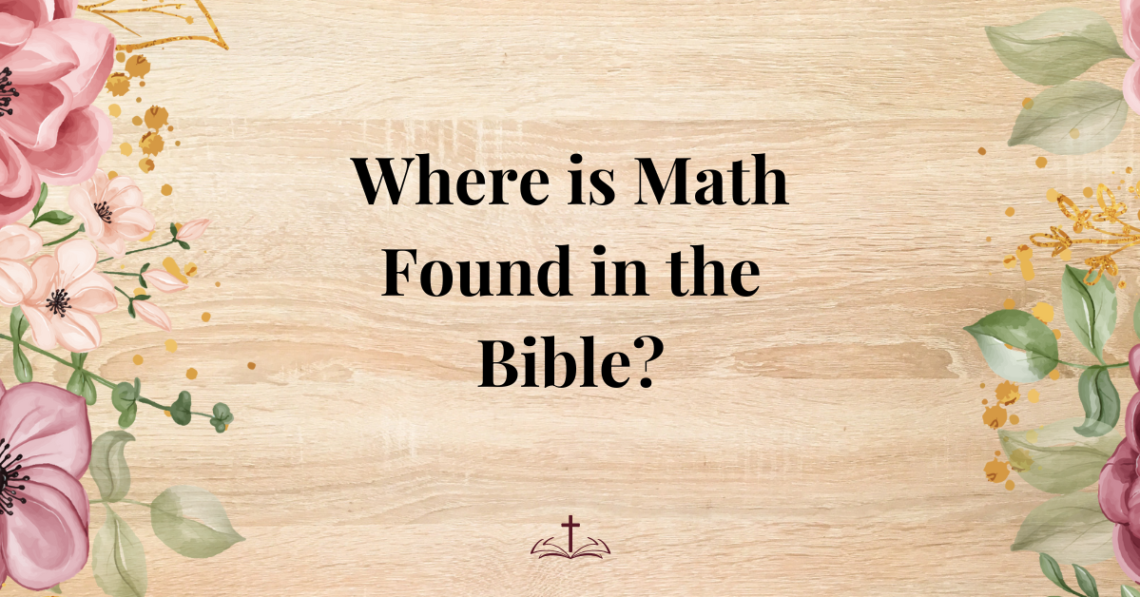The Bible, a spiritual and moral guide for billions of people, contains profound theological truths. It also holds rich numerical patterns and symbolism. Numbers in the Bible aren’t incidental; they carry deep meanings that help convey divine truths and principles. Through numbers, God communicates His order, power, and design in ways that transcend mere mathematics. Let’s explore how numbers and mathematics in the Bible reflect divine wisdom and enhance our understanding of Scripture.
Numerical Symbolism in the Bible
1. The Number 1: Unity and Primacy
God’s Oneness: The number one is the foundation of all mathematical and spiritual understanding. It symbolizes unity and singularity, reflecting God’s unique nature. In Deuteronomy 6:4, God commands, “Hear, O Israel: The Lord our God, the Lord is one.” This powerful declaration emphasizes that God does not divide into parts. He is a unified whole. The concept of God’s oneness is foundational to monotheistic faith. It expresses His indivisibility and sovereignty over all creation.
2. The Number 3: Divine Completeness and Perfection
The Holy Trinity: The number three is deeply embedded in the Christian faith, symbolizing divine completeness. It is most famously represented by the Holy Trinity—Father, Son, and Holy Spirit. Jesus’ resurrection on the third day (1 Corinthians 15:4) emphasizes Christ’s triumph over death and the fulfillment of God’s redemptive plan. The use of three in scripture reflects the totality of God’s actions, presence, and character.
Key Bible Events in Threes: Numerous key biblical moments feature the number three. Jonah spent three days in the belly of the fish (Jonah 1:17). Jesus prayed three times in the Garden of Gethsemane (Matthew 26:44). Peter’s three denials were followed by his restoration (John 21:15-19). These events signify completeness and divine purpose in pivotal moments.
3. The Number 7: Perfection and Completion
Creation and Sabbath: Seven is one of the most powerful numbers in the Bible. It symbolizes perfection and completion, appearing repeatedly in both the Old and New Testaments. God created the world in six days and rested on the seventh, making the seventh day a holy day of rest (Genesis 2:2-3). This action sets a divine pattern of work and rest, repeated throughout Scripture. The seventh day symbolizes divine completion, not just in the creation of the world, but also in the spiritual renewal found in resting in God’s work.
Biblical Examples: The number seven appears frequently in the Book of Revelation. It appears in several contexts—seven churches (Revelation 1:4), seven seals (Revelation 5:1), seven trumpets (Revelation 8:6), and seven bowls (Revelation 16:1). These references emphasize the complete and final fulfillment of God’s plan in the end times.
4. The Number 12: Divine Governance and Authority
God’s Covenant People: The number twelve symbolizes divine authority, governance, and covenant. The twelve tribes of Israel (Genesis 35:22-26) represent God’s chosen people. Likewise, Jesus selected twelve apostles to spread His message and establish His church (Matthew 10:2-4). The twelve tribes and apostles signify a complete and divinely established community, guided by God’s law and grace.
The New Jerusalem: In Revelation 21:12-21, the New Jerusalem, the eternal dwelling place of God’s people, features twelve gates made of twelve pearls. The twelve tribes of Israel inscribe their names on them. This highlights the ongoing covenant between God and His people, both in the Old and New Testament.
Mathematical Patterns and Structures
1. Genealogies and Ages: Divine Order
Mathematical Precision: The genealogies in the Bible, especially in Genesis, reveal God’s meticulous design. The ages of the patriarchs, while seeming like simple numbers, often reflect divine order and timing. For example, Noah was 600 years old when the flood began, marking a specific divine moment in history (Genesis 7:6). These precise ages are not only part of the historical record. They demonstrate God’s purposeful unfolding of His plan across generations.
Numerical Patterns: Certain genealogies follow mathematical patterns. The age of the patriarchs in Genesis 5 follows a structured pattern, emphasizing the orderliness of God’s creation and plan.
2. Prophetic Timelines: God’s Sovereignty Over Time
Seventy Weeks of Daniel: In the Book of Daniel, the prophecy of seventy weeks (Daniel 9:24-27) lays out a specific timeline of 490 years. It spans from the rebuilding of Jerusalem to the coming of the Messiah. These “weeks” are interpreted as years, each contributing to the unfolding of God’s redemptive plan. This detailed prophecy underscores God’s sovereignty over history and His perfect timing.
Jesus’ Fulfillment of Prophecies: Jesus’ life and ministry adhere to prophetic timelines. His arrival at the appointed time, as foretold by the Old Testament prophets, demonstrates the mathematical precision in God’s plan of salvation.
3. Sacred Spaces: Divine Geometry
The Tabernacle and Temple: The dimensions of the Tabernacle and later the Temple in Jerusalem are described with remarkable precision. In Exodus 25-40, God gives Moses detailed measurements for the construction of the Tabernacle, a portable place of worship. Similarly, Solomon’s Temple, described in 1 Kings 6, had specific dimensions. For instance, the Holy of Holies was a perfect cube, emphasizing the sacredness and perfection of God’s dwelling place among His people. These precise measurements were not arbitrary. They were divinely ordered to reflect God’s holiness and perfection.
The Significance of Numerology
While numerology in the Bible should not be confused with mystical or occult practices, the Bible’s use of numbers is deeply theological. Numbers reveal divine truths, express God’s character, and communicate His sovereign plan. Through these numbers, we see God’s perfection, His authority, and His intentional design for the world.
Conclusion: Embrace the Math of Faith
The Bible is not just a spiritual guidebook. It is a beautifully crafted narrative filled with intentional structure and divine order. The mathematical principles within the Bible reflect God’s character and His ultimate plan for humanity. As you dive deeper into Scripture, consider the significance of the numbers that appear throughout its pages. These numerical patterns invite us to reflect on God’s sovereignty, completeness, and perfect order.
How do these biblical numbers and patterns influence your understanding of God’s Word? Share your thoughts in the comments below! Dive deeper into God’s Word and explore the divine order in the numbers that speak to the heart of faith. What new insights can you uncover by studying the numerical symbolism in the Bible? I’d love to hear your reflections!





